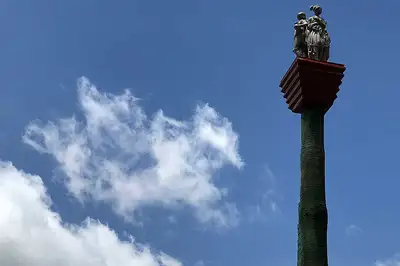
Workers installing the statues on top of Column Vernaculus.
Column Vernaculus, by New Zealand artist Warren Viscoe, has found a new home on Massey University’s Manawatū campus.
Its creator, born in Auckland in 1935, makes sculptures from found objects, re-cycling, carving, hewing, and binding them to his purpose.
Initially commissioned and funded by the Massey University College of Education Students Association, he created this sculpture in 1989 and resided at the University’s former Hokowhitu site. Work began to strengthen and relocate it to the Manawatū campus after the sale of the site in 2016.
After significant work to the sculpture, it was ready to be transported and installed earlier this week. It is now located at the campus between Science Tower A and B, a high foot traffic zone between the Orchard Road car park and the bus terminal.

Column Vernaculus.
About the sculpture and the artist
Susan Abasa, from Massey’s Museum Studies Programme, says that the sculpture uses disparate elements.
“There is a treated wooden column into which a series of tapering wooden planks have been fitted in arced formality. Four graces, not the three daughters of Zeus, stand arms entwined on the top.”
Dr Abasa says its physical security is now assured – but its meanings remain “tantalisingly fluid”.
“Column Vernaculus has been created in the familiar Kiwi vernacular, an ironic play on – and against – authority,” Abasa says. “In this case, the Classical architectural order run up by competent carpenters with few planning tools to provide simple elegant structures. The Georgian era revived this form sometimes adding a basic platform to support figurines.
“Viscoe directs us to a gently satirical examination of ‘order’, the ‘graceful’ and ‘useful’. He reminds us that cultural transplants are not only a shift in place and time but involve a restructuring and re-telling of historical values. This is serious business. While we contemplate a classical monument – we also realise solemnity has been subverted by the equality principle – quite literally ‘Jack is as good as his mistresses’.
“His resourcefulness doesn’t stop with materials and methods. Quite the contrary. In this sculpture we recognise Viscoe’s canny command of working with found objects as well as his wry humour.”